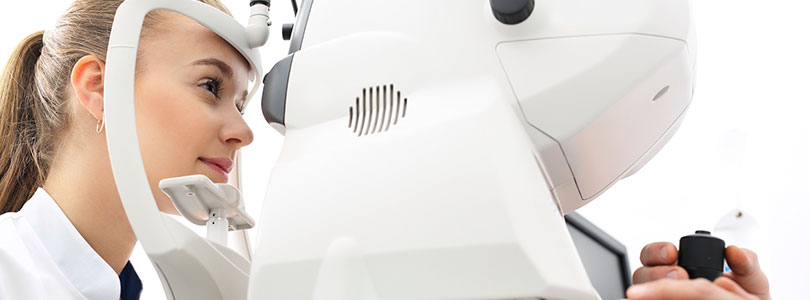Optical Coherence Tomography

Optical Coherence Tomography (OCT), is non-invasive, non-contact imaging technique used to obtain high resolution cross-sectional images of the retina.
OCT is analogous to ultrasound B-scan imaging except that light rather than sound waves are used in order to obtain a much higher longitudinal resolution of approximately 10 microns in the retina.
In OCT, a light beam projected onto the retina is reflected from the retina and from the reference mirror at a known distance. Then a specialized system electronically detects, collects, processes and stores these echo patterns, creates a cross-sectional image of the retina, performs the necessary linear, area and volumetric measurements, and displays the results onto the monitor for evaluation and analysis purposes.
Why it is performed
OCT has been shown to be clinically useful for evaluation of vitroretinal disease (such as macular holes, macular edema, age-related macular degeneration, epiretinal membranes) and glaucoma. Particularly, it is used to:
- Examine the retina and the retinal structures (such as the macula, retinal pigment epithelium, and retinal nerve fiber layer).
- Examine the extent of retinal defects or abnormalities caused by trauma or various eye diseases including (among others), macular degeneration, retinal detachment, macular hole, macular edema, and epiretinal membrane.
- Perform detailed measurements of the retina (such as thickness of the macula and its sub-layers) and the optic nerve head (such as volumetric and area measurements) to determine the specific causes of various eye disorders and develop the treatment plan, such as surgical intervention.
- Monitor the outcomes of treatment procedures over time.
How to prepare
No special preparation is required for the OCT examination.
How it is performed:
- The patient is asked to position his or her head in the head mount and fixate on a target light either inside the ocular lens (internal fixation) or outside to the ocular lens (external fixation) if the internal fixation method is selected, the patient’s fellow eye is covered while scanning. This enables the patient to fixate more steadily.
- During positioning, what the patient sees with the study eye is a rectangular field of red punctuated with a green target light. Normally, the patient can look at this field for several minutes at a time without discomfort or tiredness.
- During scan alignment, the patient sees the scan pattern in motion on the red field. It is traced rapidly at first, while in scan alignment mode, then more slowly in scan acquisition mode.
- Finally, during scan acquisition, the patient sees a bright greenish-white flash, like a camera flash. This is the video camera acquiring a red-free fundus image for storage with the scan. Except for the most photosensitive, the flash should not be uncomfortable, and the patient may experience numerous such flashes without harm.
Subsequently the patient demographic data is collected or retrieved from the OCT system database and the acquired images are linked with the patient.
The OCT examination takes 5-10 minutes.
Results
The results vary significantly depending on the condition being studied and the patient.
How it feels
The OCT procedure is considered painless.
What the risks are
OCT examination is a non-invasive procedure and as such is not associated with any risks. However, some people have adverse reactions to dilating drops. Side effects are rare, but could include an increased intraocular pressure or increased blood pressure.
